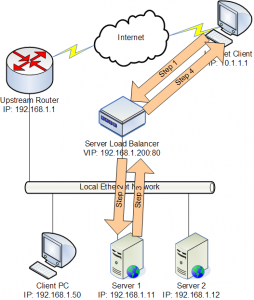- Cisco Community
- Technology and Support
- Data Center and Cloud
- Application Networking
- Load Balancer Question.
- Subscribe to RSS Feed
- Mark Topic as New
- Mark Topic as Read
- Float this Topic for Current User
- Bookmark
- Subscribe
- Mute
- Printer Friendly Page
Load Balancer Question.
- Mark as New
- Bookmark
- Subscribe
- Mute
- Subscribe to RSS Feed
- Permalink
- Report Inappropriate Content
03-07-2012 03:53 AM
| Step | Connection | Source IP | Destination IP |
| 1 | Client -> LB | 10.1.1.1 | 192.168.1.200 |
| 2 | LB -> Server | 10.1.1.1 | 192.168.1.11 |
| 3 | Server -> LB | 192.168.1.11 | 10.1.1.1 |
| 4 | LB -> Client | 192.168.1.200 | 10.1.1.1 |
In given chart would like to understand 2nd and 3rd step. As per my understanding nat should take place on 2nd step and the real server should get the hit from VIP IP if souce nat is not configured.
Q- what should the source IP will be hitting the actual server ? (STEP 2)
Q- I have also seen we get the actual source initiating the connection hits the server how would that works ?
Q-If souce nat is configured and client reside in same vlan as real servers how would session table look like ?
Also if someone can also explain how does x-forwarding works here.
Thanks
Ajay

- Labels:
-
Application Networking
- Mark as New
- Bookmark
- Subscribe
- Mute
- Subscribe to RSS Feed
- Permalink
- Report Inappropriate Content
03-07-2012 03:13 PM
Hi,
Regarding your questions:
Q- what should the source IP will be hitting the actual server ? (STEP 2)
A/ Assuming that you are not doing NAT in your LB, the source IP on the server is going to be the original client IP: 10.1.1.1.
Q- I have also seen we get the actual source initiating the connection hits the server how would that works ?
A/ In that diagram, there are 2 ways for that to happen, 1) the server is using the LB as the default gateway, so all the traffic that is not from the local subnet, is going to be sent to the LB as the next hop, and that will complete the flow on the LB. 2) there is another L3 device on the server subnet either using routing or PBR in order to send the reply back to the LB.
Q-If souce nat is configured and client reside in same vlan as real servers how would session table look like ?
A/
| 1 | Client -> LB | 192.168.1.50 | 192.168.1.200 |
| 2 | LB -> Server | 192.168.1.201 | 192.168.1.11 |
| 3 | Server -> LB | 192.168.1.11 | 192.168.1.201 |
| 4 | LB -> Client | 192.168.1.200 | 192.168.1.50 |
Where 192.168.1.201 is my NAT IP.
Regarding the X-Forwarder-For, usually this is used when you are using NAT, so the client IP is included on the HTTP headers, so the servers can keep track of the client IP's, but it depends on the LB and if the feature is supported, also you need to take into account the protocol you are load balancing, it works for HTTP.
Hope it helps.
Discover and save your favorite ideas. Come back to expert answers, step-by-step guides, recent topics, and more.
New here? Get started with these tips. How to use Community New member guide
